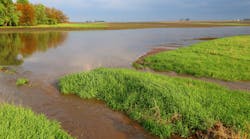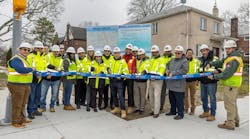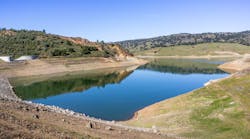The Texas Water Development Board (TWDB) announced the five winners of its annual Texas Rain Catcher Award, a rainwater harvesting competition and recognition program.
TWDB says that the award recipients displayed excellence in rainwater harvesting in Texas in four categories: agricultural, commercial, educational, and governmental.
The five winners are as follows:
Agricultural Category
Bill Nash/Raven Canyon LLC won an award for its rainwater harvesting system.
Raven Canyon uses rainwater harvesting in various forms to evenly distribute water to its fruit tree orchards and gardens year-round. By collecting excess rainfall, Raven Canyon can store and redistribute water over a longer period using 5,000 feet of drip lines, providing higher quality water for better fruit production while avoiding the cost of procuring water from other sources.
The entire canyon is managed for rainwater collection with the ability to store more than 27,000 gallons of water. The system includes three pressurized UV-filtered systems, a 10,000-gallon concrete reservoir, three 2,500-gallon accessory storage tanks, plus nine rock dams and two stock tanks located at the bottom of the canyon. Habitat restoration on the site has also changed the water and mineral cycles of Raven Canyon and allowed more effective absorption and filtration.
Pecan Spring Ranch also won in the agricultural category for its rainwater harvesting system.
The rainwater harvesting system at Pecan Spring Ranch makes use of history to supply water to their livestock, gardens, and area wildlife. The ranch has transformed its Red Barn, a Dutch barn built around 1898, into the catchment surface for their system by retrofitting it with metal roofing and 12-inch stainless steel box gutters on each side.
Pecan Spring Ranch’s rainwater collection system consists of three storage areas: a 25,000-gallon covered rock tank, a 1,000-gallon stainless steel tank, and a 2,000-gallon clay-lined surface water pond, for a combined storage total of 28,000 gallons. Rainwater fills the tanks first before overflow is piped underground to the pond, which also collects surface runoff. Collecting rainwater has saved Pecan Spring Ranch money by reducing the need to use and maintain the existing water well, which also reduces reliance on local groundwater and eliminated the need and cost of drilling a new well.
Commercial Category
Grundfos Headquarters won with its rainwater harvesting and treatment system.
Grundfos North America’s rainwater harvesting system has reduced potable water consumption by more than 86 percent annually, and the entire project has received Leadership in Energy and Environmental Design (LEED) platinum certification and exemplary performance for water conservation. The water is used for the cooling tower, all flush fixtures, the courtyard water fountain, and pumps and equipment used in a flexible exhibition area.
The project harvests and treats rainwater onsite, collecting from two buildings and the courtyard area of the main office building totaling 31,730 square-feet. Water is stored in two 50,000-gallon underground storage tanks before being distributed to the utility building where it is processed through the Grundfos AQ-Pure water treatment system, the first of its kind in the United States. Based on the capture area and annual average rainfall, the project team anticipates the system will collect approximately 873,183 gallons of rainwater annually.
Educational Category
Reilly Elementary School won the award in the educational category for its green stormwater retrofit
The Reilly Elementary School project uses passively draining cisterns designed to capture and store rainwater, allowing it to infiltrate into the ground instead of flowing directly into streams, which contributed to poor water quality, erosion, and minor flooding. Some system components are plumbed to watering spigots and a chicken coop watering bowl with the option to use outputs for additional needs. The project demonstrates to students and the public how rainwater harvesting and rain gardens can be used as a water source to beautify the landscape, reduce common erosion problems, and provide continued learning opportunities.
The project uses 12 cisterns of various sizes and materials, along with five rain gardens, to capture rainwater from 76,627 square feet of rooftops and parking lots. The system reduces runoff from the site by an estimated 621,785 gallons per year, with much of it infiltrating back into the ground.
Governmental Category
Lastly, Prairielands Groundwater Conservation District won in governmental category for its rainwater harvesting program
Prairielands Groundwater Conservation District offsets the demands and potential environmental impacts of its new office facility by using the rooftop footprint to capture rainwater. The District installed two metal cisterns along with a rain garden and native plant beds that use the rainwater harvesting system for irrigation. Additionally, the District promotes rainwater harvesting with a robust education program to correspond with the onsite utilization. The District’s Water Education Trailer includes a rainwater harvesting model with a rainfall simulator, water collection calculator, and diorama of a traditional residential rainwater harvesting system.
Between the cisterns and rain garden, an average of 80,000 gallons of water is captured over the course of a year. The system has proven useful and cost effective by providing a dependable water source that allows the District to water efficiently through drip irrigation instead of relying on the public water supply.



